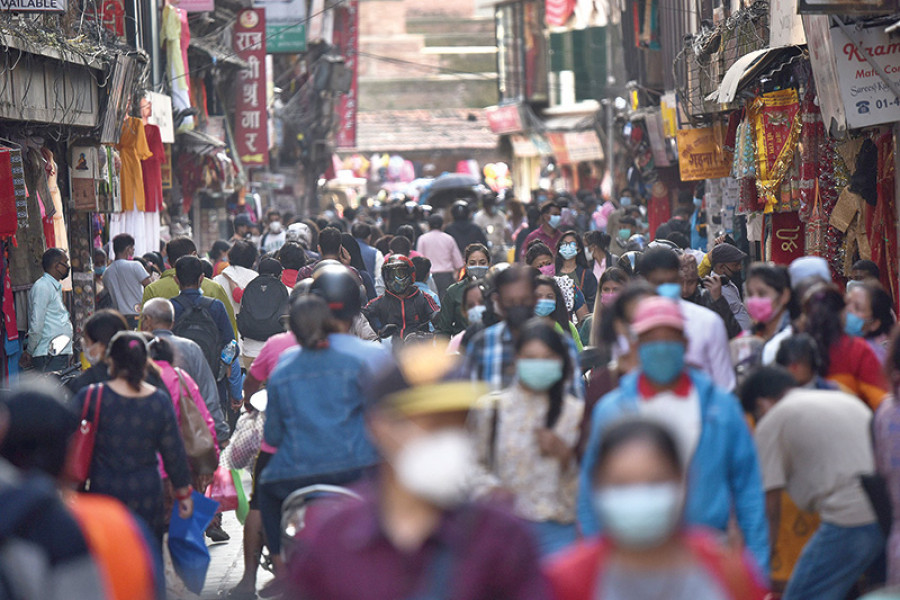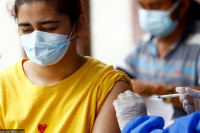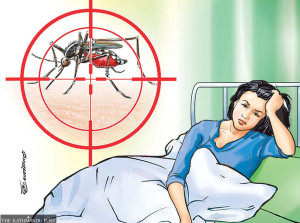Health
One in eight individuals exposed to virus until September, seroprevalence survey shows
A seroprevalence of 13 percent–Province 2 tops the list at 23 percent followed by Bagmati at 17 percent–is too high, public health experts say.
Arjun Poudel
Around 13 percent of the country’s population has been found to have been infected with the coronavirus until September, according to a seroprevalence survey carried out by the Ministry of Health and Population.
The nationwide study, which was conducted with technical as well as financial support from the World Health Organisation, found the highest Covid-19 prevalence in Province 2, followed by Bagmati Province, Province 1, Lumbini Province, Gandaki Province, Sudurpaschim Province and Karnali Province, suggests the report, which is yet to be made public.
A seroprevalence survey is a study carried out to determine the extent of infection in the general population. A serology test examines the presence of antibodies in the human body.
“We have already furnished the report to the Health Ministry,” Dr Basudev Pandey, director at the Epidemiology and Disease Control Division, told the Post. “The ministry is likely to make the findings public in a few days.”
Pandey refused to give further details, saying he was not authorised to speak about the report.
At least four officials who have seen the report said the survey has found the virus spread at an alarming rate as it shows close to 15 percent of the population to have contracted the coronavirus until September.
Mahendra Prasad Shrestha, chief specialist at the Health Ministry, said the report is with the ministry and that they are “still studying it”.
While Health Ministry officials said that the seroprevalence survey was conducted in over 3,100 samples—450 samples from each province, officials at the Epidemiology and Disease Control Division said over 6,000 samples were collected from 75 districts throughout the country. Samples were not collected from Rasuwa and Manang, according to the officials.
Since a seroprevalence survey uses antibody tests to estimate the percentage of people in a population who have antibodies against Sars-Cov-2, a small sample of people participating in the survey represents a larger population.
Public health experts say data obtained from a seroprevalence study can provide a fair picture of the infection rate in communities, thereby helping the authorities locate hotspots and take various necessary measures accordingly.
“I am not aware of the survey findings, but if the report suggests 13 percent of the participants have antibodies against the coronavirus, then this is a huge number,” Dr Anup Subedee, an infectious disease expert, told the Post. “Since such a survey helps estimate the spread of the virus in the communities, from the data until September, we can easily understand today’s situation.”
According to him, if the virus had spread to such a large population until then, a lot more could have been infected by now.
“We can also analyse with the findings as to how many tests were performed and what results they gave,” Subedee told the Post. “The data can also provide insights into whether we matched the number of tests with the disease prevalence and whether we did testing as per the prevalence rate.”
Of late, the number of Covid-19 cases, according to the Health Ministry, has been low, but experts say that could be because fewer tests are taking place.
As per an October 5 Cabinet decision, the government has halted free testing and contact tracing for asymptomatic patients.
Nepal reported its first Covid-19 case in the third week of January. On March 24, the country went into a lockdown, which lasted until July 21. Since the lockdown was lifted, safety protocols have not been strictly followed. Except for some public places like party palaces, schools, colleges and stadiums, almost everything has been operating.
So far, 1,538 people have died of Covid-19 in the country.
According to officials familiar with the survey report, 23 percent of those who participated in the survey in Province 2, highest of all provinces, have been found to have been infected with the virus. Likewise, 17 percent of those participating in the survey in Kathmandu Valley were found to have antibodies against the virus. In Province 1, 13 percent of those participating in the survey had antibodies against the virus.
As of Wednesday, 236,246 people have tested positive for the disease throughout the country, with 1,538 deaths. In the last 24 hours, 1,490 people tested positive, including 723 in Kathmandu Valley. The ministry said that 218,161 people have recovered so far.
After announcing the end of lockdown, the Health Ministry had said in July that it would conduct a seroprevalence survey on around 7,500 people across the country.
Results of seroprevalence surveys conducted in different countries show their numbers to be on the lower side—less than 10 percent.
The United States has a seroprevalence of 9.3 percent, Switzerland 8 percent, the United Kingdom 7 percent and Belgium 5 percent.
A second seroprevalence study carried out by the Indian Council of Medical Research in August in India showed only 6.6 percent of the population in the country were exposed to the virus.
A Health Ministry official said discussions are underway whether to conduct a second round of seroprevalence survey.
“The results that we have from the survey until September are alarming,” said the official. “We are mulling over conducting the survey on a large scale. We are in consultation with the officials from the Central Bureau of Statistics and they too have suggested that we conduct a second survey on a large scale.”
Dr Sher Bahadur Pun, chief of the Clinical Research Unit at Sukraraj Tropical and Infectious Disease Hospital, said that a lot more people might have been infected as of now, as the coronavirus spreads exponentially—one person infecting three and those three infecting nine other people.
“We have neither enforced any strict restrictions nor increased tests since September,” Pun told the Post. “Movements of the people increased due to festivals. If we conduct another seroprevalence survey now, the results could be even more alarming.”




 15.12°C Kathmandu
15.12°C Kathmandu














